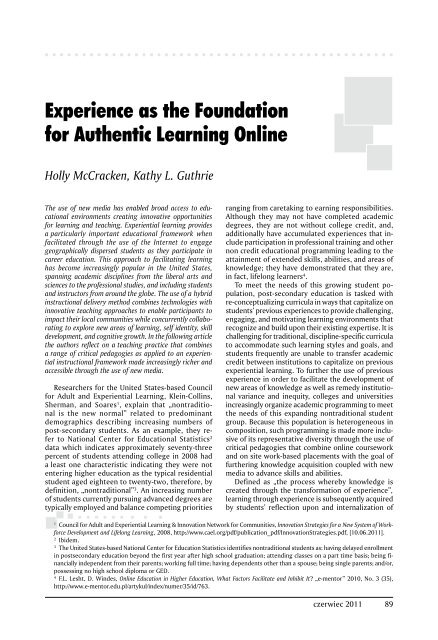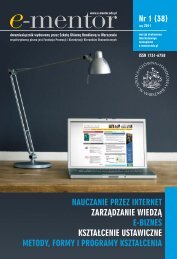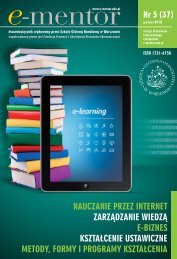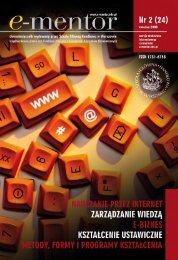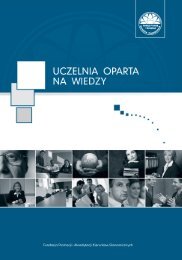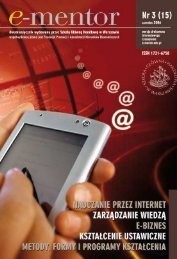metody, formy i programy ksztaÅcenia - E-mentor
metody, formy i programy ksztaÅcenia - E-mentor
metody, formy i programy ksztaÅcenia - E-mentor
You also want an ePaper? Increase the reach of your titles
YUMPU automatically turns print PDFs into web optimized ePapers that Google loves.
Experience as the Foundationfor Authentic Learning OnlineHolly McCracken, Kathy L. GuthrieThe use of new media has enabled broad access to educationalenvironments creating innovative opportunitiesfor learning and teaching. Experiential learning providesa particularly important educational framework whenfacilitated through the use of the Internet to engagegeographically dispersed students as they participate incareer education. This approach to facilitating learninghas become increasingly popular in the United States,spanning academic disciplines from the liberal arts andsciences to the professional studies, and including studentsand instructors from around the globe. The use of a hybridinstructional delivery method combines technologies withinnovative teaching approaches to enable participants toimpact their local communities while concurrently collaboratingto explore new areas of learning, self identity, skilldevelopment, and cognitive growth. In the following articlethe authors reflect on a teaching practice that combinesa range of critical pedagogies as applied to an experientialinstructional framework made increasingly richer andaccessible through the use of new media.Researchers for the United States-based Councilfor Adult and Experiential Learning, Klein-Collins,Sherman, and Soares 1 , explain that „nontraditionalis the new normal” related to predominantdemographics describing increasing numbers ofpost-secondary students. As an example, they referto National Center for Educational Statistics 2data which indicates approximately seventy-threepercent of students attending college in 2008 hada least one characteristic indicating they were notentering higher education as the typical residentialstudent aged eighteen to twenty-two, therefore, bydefinition, „nontraditional” 3 . An increasing numberof students currently pursuing advanced degrees aretypically employed and balance competing prioritiesranging from caretaking to earning responsibilities.Although they may not have completed academicdegrees, they are not without college credit, and,additionally have accumulated experiences that includeparticipation in professional training and othernon credit educational programming leading to theattainment of extended skills, abilities, and areas ofknowledge; they have demonstrated that they are,in fact, lifelong learners 4 .To meet the needs of this growing student population,post-secondary education is tasked withre-conceptualizing curricula in ways that capitalize onstudents’ previous experiences to provide challenging,engaging, and motivating learning environments thatrecognize and build upon their existing expertise. It ischallenging for traditional, discipline-specific curriculato accommodate such learning styles and goals, andstudents frequently are unable to transfer academiccredit between institutions to capitalize on previousexperiential learning. To further the use of previousexperience in order to facilitate the development ofnew areas of knowledge as well as remedy institutionalvariance and inequity, colleges and universitiesincreasingly organize academic programming to meetthe needs of this expanding nontraditional studentgroup. Because this population is heterogeneous incomposition, such programming is made more inclusiveof its representative diversity through the use ofcritical pedagogies that combine online courseworkand on site work-based placements with the goal offurthering knowledge acquisition coupled with newmedia to advance skills and abilities.Defined as „the process whereby knowledge iscreated through the transformation of experience”,learning through experience is subsequently acquiredby students’ reflection upon and internalization of1Council for Adult and Experiential Learning & Innovation Network for Communities, Innovation Strategies for a New System of WorkforceDevelopment and Lifelong Learning, 2008, http://www.cael.org/pdf/publication_pdf/InnovationStrategies.pdf, [10.06.2011].2Ibidem.3The United States-based National Center for Education Statistics identifies nontraditional students as: having delayed enrollmentin postsecondary education beyond the first year after high school graduation; attending classes on a part time basis; being financiallyindependent from their parents; working full time; having dependents other than a spouse; being single parents; and/or,possessing no high school diploma or GED.4F.L. Lesht, D. Windes, Online Education in Higher Education, What Factors Facilitate and Inhibit It? „e-<strong>mentor</strong>” 2010, No. 3 (35),http://www.e-<strong>mentor</strong>.edu.pl/artykul/index/numer/35/id/763.czerwiec 2011 89


